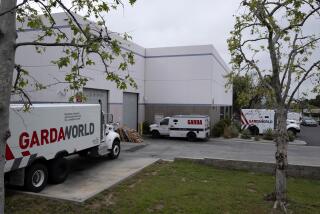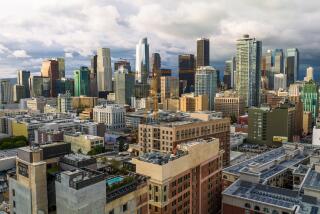New York a City in Flux as Its Economy Struggles
NEW YORK â Had the terroristsâ goal been sheer economic destruction, they hardly could have hit a bigger target.
Where else in the United States--or the world, for that matter--could such a strike cause losses approaching $100 billion?
One year after the World Trade Center attack, New York Cityâs economy is struggling, lagging behind the nation in job creation and economic output after several years of stock market-fueled brilliance.
Gothamâs troubles are more than symbolic, however, because the half-trillion-dollar regional economy represents about 5% of total U.S. gross domestic product.
Job losses due to the attack have been estimated at more than 86,000, including 13,000 jobs shifted to other areas, said the Fiscal Policy Institute, a private research group. In a local economy of more than 5 million jobs, that amounts to less than 2%.
Even before the attack, though, New Yorkâs economy was slowing, partly because of the stock marketâs doldrums and a wave of layoffs underway in the financial sector. Pushed largely by Sept. 11-related job losses, the cityâs unemployment rate hit 8.0% in June, up from 5.7% a year earlier.
Manhattanâs downturn began in January 2001, two months ahead of the nationâs, said regional economist Jason Bram of the Federal Reserve Bank of New York. The cityâs slump isnât officially over, but experts are cautiously optimistic that New York will continue a moderate recovery next year, along with the nation.
Despite severe stress on municipal finances, the cityâs credit ratings have held up well. Moodyâs Investors Service lowered its outlook on the cityâs general obligation bonds to ânegativeâ in November, but did not downgrade the bonds.
Although experts say some economic effects of the terrorist attack may continue for years, itâs unlikely that the city will face a financial meltdown like the one it endured in the 1970s. Even during the â90s stock market boom, the cityâs budget projections were fairly conservative, and so it hasnât fallen into a comparable debt squeeze, Bram said.
âIf you were told, âWeâre going to have a recession, the stock marketâs going to fall and the World Trade Centerâs going to be destroyed,â you could imagine a much worse scenario for New York City than what we see now,â Bram said.
The local industries hardest hit by the terrorist attack include tourism, transportation, retailing, commercial real estate and, of course, financial services.
Economist Celia Chen, who follows New York for research firm Economy.com, noted that finance, insurance and real estate jobs--those most directly affected by the attack--represent 12% of the metropolitan areaâs employment base but 32% of its income.
City Comptroller William C. Thompson Jr. estimated the total cost of the attack at $83 billion to $95 billion. Of that, $30.5 billion represents property damage and lost âhuman capital,â or the productive capacity of the 2,800 people killed in the attack.
By contrast, Hurricane Andrew, which struck Florida in 1992 and was the most expensive natural disaster in the U.S., caused total losses of about $30 billion. Damage from the 1994 Northridge earthquake was placed at about $20 billion.
By Thompsonâs calculations, New Yorkâs âgross city productâ over the next two years will be down $25 billion to $37 billion because of the attack.
The final tally, he said, will depend on how many relocated jobs return to New York.
Budget Gap
The loss of tax revenue and additional expenses has hobbled city government, costing an estimated $3 billion, which with the already-weak economy, led to a $6-billion budget gap for the current fiscal year--a shortfall that is being made up through borrowing and spending cuts in city departments.
Mayor Michael R. Bloomberg is slashing 20% from the budget of his own office, aide Jordan Barowitz said. Libraries and cultural affairs agencies face 10% cuts. The public safety and school departments will fare slightly better, with cuts in the single digits, he said. âWeâre doing as much as we can not to have it affect the quality of life, but it gets increasingly difficult as more cuts need to be made,â Barowitz said.
Outside assistance has been slow to have an effect, local officials say. Although more than $21 billion in federal aid has been pledged, only $2.7 billion has been released, according to Comptroller Thompsonâs report.
There also has been controversy over how the aid has been targeted. One group representing small-shop owners in the devastated Financial District contends that big Wall Street firms are getting a disproportionate share of the aid--and getting it quicker--than mom-and-pop retailers.
Vacancy rates for prime commercial real estate in downtown Manhattan more than doubled to 11.5% in July 2002 from a year earlier, despite the elimination of 13 million square feet of office space at ground zero and damage to a nearly equal amount of space in the surrounding area.
âYou would have thought the destruction of so much property would have firmed up demand,â Chen said. Instead, a number of companies moved workers north to Midtown or to New York or New Jersey suburbs.
Wall Street giants Morgan Stanley and Goldman Sachs Group Inc., for example, are maintaining a significant presence in the Financial District, yet are shifting thousands of workers to New Jersey and Westchester County, N.Y. The New York Stock Exchange dropped plans to erect a new Wall Street headquarters and instead will split its operations between its downtown site and a new facility at a so-far-undisclosed location, but most likely not in Lower Manhattan.
To the relief of city officials, Merrill Lynch & Co. quickly returned to the World Financial Center with most of its employees and plans to stay there. Similarly, American Express Co. is in the process of moving employees back to the Financial District; it eventually will have 4,000 workers there, about the same number as before the attack, spokeswoman Molly Faust said.
More Complicated
At street level, the situation may be more complicated.
Downtown locksmith Peter Argese had several important commercial customers in the World Trade Center. The attack wiped out those accounts, at least temporarily, and reduced his overall business by about one-third, he said.
On the other hand, the havoc in Lower Manhattan brought Argese one benefit: When declining sales forced a cellular telephone retailer out of business in June, Argese was able to move into the vacated storefront in the heart of the Financial District at a monthly rent of $3,000--$2,000 less than the phone dealer had been paying.
Better still, business is picking up at the shop, which employs six people. âIt was slow for a while, but now itâs real busy,â Argese said.
Mark Goldberg, principal of Bronx Builders, a contracting company that specializes in high-end hotel and restaurant construction, lost three employees at the World Trade Center, including the highly skilled head of his millworking operation.
The three men--immigrants from Paraguay, Portugal and Romania--were visiting a prospective job site at Windows on the World restaurant on the 107th floor of the North Tower when the plane struck.
âThere was a level of disbelief,â Goldberg said. âWe closed down the shop for about a week. Nobody had the heart to work.â
Anticipating an economic crash, some customers got cold feet, canceling jobs that were all but underway, Goldberg said. Bronx Builders, which has revenue of $12 million to $15 million a year, saw business shrink about 15%, he said.
Goldberg was forced to quickly scale down to 35 employees from 85 and subcontract a far larger portion of his work, he said. Business has come back more strongly than he expected, but the climate has changed for good.
âItâs more competitive now,â Goldberg said. âEverybodyâs chasing work more aggressively.â
The caution among some of Goldbergâs restaurant and hotel clients partly reflects the precipitous drop in tourism that followed the Trade Center attack.
Tourism Declines
NYC & Co., the cityâs tourism bureau, estimated that 32 million tourists will visit New York this year, down from 37 million in 2000, which will mean a decline of more than $2 billion in spending.
In many cases, foreign tourists have been replaced by domestic visitors who donât stay as long or spend as much money, experts say.
Still, tourism and retailing rebounded fairly well, considering how sharply they fell off just after the attack, said James Brown, analyst for the New York State Labor Department.
Attendance at Broadway shows, with the campy musical âHairsprayâ this seasonâs hottest ticket, also has snapped back better than expected. Several shows closed immediately after the attack, and it took city subsidies and pay concessions from performers and craftspeople to get the industry through a bleak fall and winter.
New Yorkâs Chinatown has a lower economic profile than Broadway or Wall Street, yet its chief businesses--restaurants, small retailers and garment factories--were no less battered.
Beset by lower-cost foreign competitors, the garment industry has been shrinking for many years, but the attack accelerated the process. The street blockades, which closed off the southern half of Chinatown, made it impossible for many companies obtain fabric and other materials or to deliver their finished goods.
The big retailers that buy from the garment factories âmay have been looking for an excuse to cancel orders anyway,â anticipating a slow holiday shopping season, said James Parrott, chief economist for the Fiscal Policy Institute.
Five months after the attack, at least 40 of the neighborhoodâs 246 garment factories had closed their doors for good and an estimated 70% of apparel workers were working reduced hours, according to a study by the Asian American Federation of New York.
The Chinatown womenâs wear factory that employs Agnes Wong and about 15 others was shut down for nearly four months and still is not running at full capacity, Wong said. The Hong Kong native considers herself lucky because, after 28 years in the low-wage industry, she has accumulated enough savings to survive the downturn.
Despite wages that make it difficult to bring home more than $40 for a dayâs work, the garment industry is crucial to Chinatownâs quality of life, Wong said. It is one of the few businesses that offers flexible hours for immigrants who donât speak English and have young children at home.
Small-Business Woes
Farther south and also overshadowed by Wall Street, another group is struggling for survival: the small-business owners of the Financial District.
From the Ground Up, an organization claiming 400 entrepreneur members, has been pressuring government for quicker action on aid.
Board member Anastasia Gagas, whose mail-forwarding business was in the northeast corner of the World Trade Center complex, said $600 million in federal assistance has been earmarked for small businesses hurt by the terrorist attack, but only a trickle has been delivered.
She contended that city and state officials administering the federal funds are responding faster, and more generously, to huge Wall Street firms than to small-business owners.
There is too much red tape involved in obtaining the government aid and the amount provided is too small, she said. One program offers a maximum payment equal to 25 days worth of sales.
But for a merchant like her whose business has been shut since the attack, it isnât enough. âWhereâs my other 300 days of sales?â she asked.
To make matters worse, many shop owners are fighting their insurers for payment of business interruption and property damage claims, Gagas said.
The plight of the small merchants isnât just an issue for the entrepreneurs themselves, Gagas said. âPeople who work downtown want to be able to go to lunch, get their shoes repaired, pick up office supplies, but they canât--weâre not there,â she said.
More to Read
Inside the business of entertainment
The Wide Shot brings you news, analysis and insights on everything from streaming wars to production â and what it all means for the future.
You may occasionally receive promotional content from the Los Angeles Times.










